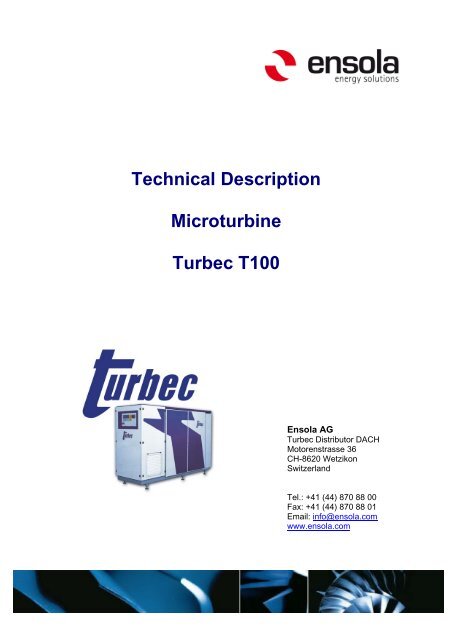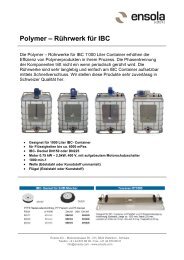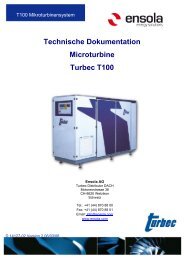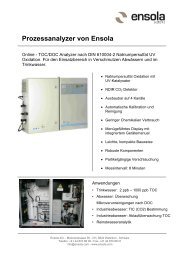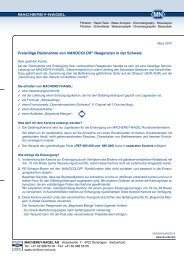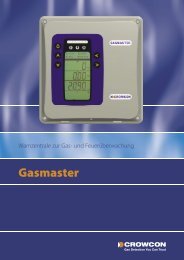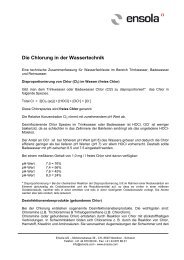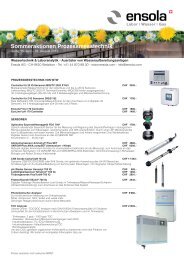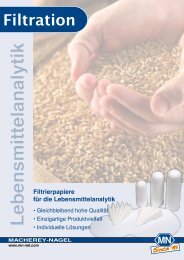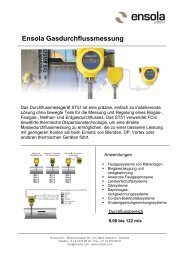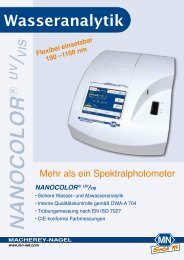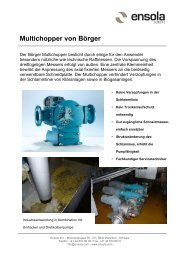Technical Description Microturbine Turbec T100 - Ensola AG
Technical Description Microturbine Turbec T100 - Ensola AG
Technical Description Microturbine Turbec T100 - Ensola AG
- No tags were found...
Create successful ePaper yourself
Turn your PDF publications into a flip-book with our unique Google optimized e-Paper software.
Contents1. <strong>T100</strong> Power module..........................31.1 Product description Power Module ... 31.2 Performance for <strong>T100</strong> P ....................... 61.3 Scope of supply and Terminalpoints for <strong>T100</strong> P ................................... 71.4 Installation of <strong>T100</strong> P ........................... 71.5 CE compliance ......................................... 91.6 Maintenance concept ........................... 91.7 Operation of <strong>T100</strong> P ............................ 102. <strong>T100</strong> Power and Heat ...................... 112.1 Product description ............................. 112.2 Performance for <strong>T100</strong> PH .................. 122.3 Scope of supply and Terminalpoints for <strong>T100</strong> PH ............................... 132.4 Installation of <strong>T100</strong> PH ...................... 142.5 CE compliance ....................................... 152.6 Maintenance concept ......................... 152.7 Operation of <strong>T100</strong> PH ......................... 153 Options ............................................. 16<strong>T100</strong> moduledescriptionThe <strong>Turbec</strong> <strong>T100</strong> microturbinesystem is a modular system designedto generate power and heat with highefficiency and low emissions. Inaddition the <strong>T100</strong> has severalcomplementary modules which canbe used in a large number ofapplications.1. <strong>T100</strong> PowerIntroduction2. <strong>T100</strong> Power and HeatThe <strong>T100</strong> Power and Heat unit(<strong>T100</strong> PH) is the <strong>T100</strong> Powermodule combined with an exhaustgas heat exchanger. Thiscombination allows the <strong>T100</strong> toproduce combined heat and powerachieving very high overallefficiencies. The hot gases leaving themicroturbine are in this case used toproduce hot water. The overallefficiency of the microturbine will inthis way be highly improved.The <strong>Turbec</strong> <strong>T100</strong> Power (<strong>T100</strong> P)produces electrical power. It can beused in processes where the hotexhaust gases are used directly fordrying, cooling etc, or powerproduction only. The <strong>Turbec</strong> <strong>T100</strong> Puses a high speed generator toproduce electricity. The compressorand the turbine are placed on thesame shaft as the generator. Anexhaust gas recuperator is connectedto the microturbine to improve theelectrical efficiency. The scope ofsupply also includes an induced draft.3. OptionsThe <strong>T100</strong> microturbine system offersthe following options:External pre-filterOutdoor installationBy-pass of heat exchangerLoad followingRemoval of fuel boosterAdditional relay protectionLog file decoderGSM modemWeekly schedulerAlternative fuels<strong>Turbec</strong> Spa D14127-02 <strong>Technical</strong> description Ver 2 2
1.1 Product description for <strong>T100</strong> Power<strong>T100</strong> Power1. Air filter2. Generator3. Air inlet4. Gas turbine engine5. Pipe from recuperator6. Recuperator7. Ventilation air outlet8. Exhaust gas outlet9. Pipe to recuperator10. Gas compressor11. Combustion chamber12. Oil pump13. Cooling water pump14. Power electronics15. Control system1.1.1 Main components for <strong>T100</strong> PThe <strong>Turbec</strong> <strong>T100</strong> P consists of the following main parts:• Gas turbine engine• Electrical generator• Electrical system• Supervision and control systemGas turbine engineThe gas turbine is a single shaft engine. The maincomponents are:• Housing• Compressor• Recuperator• Combustion chamber• TurbineHousingThe electrical generator and the rotating components ofthe gas turbine are mounted on the same shaft. The partsare mounted in the same housing.CompressorThe <strong>Turbec</strong> <strong>T100</strong> uses a radial centrifugal compressor tocompress ambient air. The pressure ratio is about 4.5:1.The compressor is mounted on the same shaft as theturbine and the electrical generator.RecuperatorThe electrical efficiency of the gas turbine is increasedwith a recuperator. The recuperator is a gas-to-air heatexchanger attached to the microturbine. The heat isexchanged from the hot exhaust gases to the compressedair that is fed to the combustion chamber.Combustion chamberThe preheated compressed air is mixed with the fuel.During start up an electrical igniter in thecombustion chamber ignites the mixture.The combustion chamber is of lean pre-mixemission type, achieving exhaust gases withlow emissions of NO x, CO and unburned hydrocarbons.TurbineThe turbine drives the compressor and the generator.When the combustion gases leave the combustionchamber the temperature is approx. 950°C (1 742°F)and pressure is approximately 4.5 bar (65 psi). As thecombustion gases expand through the turbine thepressure decreases to nearly atmospheric pressure andthe temperature drops to approx. 650°C (1 202°F).Electrical generatorThe electric power is generated by a permanent magnetrotating at high speed. The generator rotor is suspendedby two bearings, one on each side of a permanent magnet.Further more, the generator acts as an electricstarter. The generator is water-cooled, and designed forhigh conversion efficiency.Electrical systemThe high frequency AC power from the generator isrectified and converted to the desired grid voltage and netfrequency. The AC power is rectified and converted tothe electrical grid frequency. A line filter and a transformerstabilizes and smoothes the AC output. Duringstart-up, power is taken from the grid and used forelectric start of the gas turbine.Supervision and control systemThe <strong>Turbec</strong> <strong>T100</strong> is controlled and supervised by anautomatic control system that resides at the PowerModule Controller (PMC) so the unit needs no personalattendance under normal operation. In case of griddistortion or system failure the system automatically shutsdown and the fault is logged by the PMC. The PMCcontrols and supervises the start-up, running and rollout.1. Generator2. Inlet air3. Combustion chamber4. Air to recuperator5. Compressor6. Turbine7. Recuperator8. Exhaust gases<strong>Turbec</strong> SpA D14127-02 <strong>Technical</strong> description Ver 2 3
<strong>T100</strong> Power Module1. Generator2. Rectifier/Start converter3. DC bus4. Converter5. Line filter6. Transformer7. Main switchFor this purpose a set of variables are monitored throughsensors that measure:• Turbine outlet temperature• Power output• Oil and water temperature• VibrationsIn case of faults, the PMC executes one of the followingactions:• Normal stop• Emergency shut downThe fault is presented on the display at the operator´spanel to guide operating personell.1.1.2 Auxiliary systems for <strong>T100</strong> PThe auxiliary systems in the Power module are dividedinto the following systems:• Lubrication system• Cooling system• Air intake and ventilation system• Fuel gas system including fuel booster• Buffer air systemLubrication systemThe purpose of the system is to lubricate the squeezedfilm bearings on the rotor shaft. The system consists of aclosed piping system and an oil tank with an oil pumpplaced within the enclosure. A motor-driven pumpcirculates the lubrication oil. The lubrication oil circulatesfrom the bearings to an oil-to-air cooler and is cooledbelow 50°C (122°F). The PMC monitors oil pressure andoil temperature before and after the bearings to obtain areliable and continuous operation of the microturbineunit.Cooling systemThe generator is cooled with a separate closed coolingwater system placed within the enclosure.Air intake and ventilation systemA <strong>T100</strong> installed indoors draws ambient air from anoutdoor intake. As the air reaches the <strong>T100</strong>, the flow isdivided into two partial flows. The main flow acts ascombustion air in the microturbine. The secondary flowventilates the excess heat out from the Power module.An induced draft fan placed on the outside wall creates anegative pressure inside the enclosure, for safety reasonsand for cooling of the engine.The ventilation air enters the <strong>T100</strong> through an air duct.There are two air filters in the<strong>T100</strong> system,the pre filterand fine filter. The pre filter (optional supply) is placedclose to the outdoor intake of the air and the fine filter isplaced close to compressor within the enclosure forfiltering the combustion air.Fuel gas systemThe fuel gas system consists of a fuel control system and afuel booster. It is necessary to use a fuel booster to raisethe gas pressure when it is below 6 bar (g) (87 psig). Thefuel gas is taken into the fuel booster and discharged tothe fuel control system. In the combustion chamber, thefuel is mixed with preheated compressed air.Buffer air systemThe gas turbine compressor supplies the buffer air systemwith air to block the lubrication oil from entering the gasturbine engine and the generator. After the sealings, theair passes through an oil separator in which the oil mist isseparated from the air and collected in the lubrication oiltank.1.1.3 <strong>Technical</strong> data for <strong>T100</strong> PGeneral identificationType:<strong>Microturbine</strong>Manufacturer:<strong>Turbec</strong> Spa, ItalyModel:<strong>T100</strong> PApplication:Power generationUsage:Indoors (Option Outdoors)DimensionsWidth:900 mmHeight:1 810 mmLength:2 770 mmWeight:2 250 kgFuel:Natural gasAmbient inlet temperature: -25°C to 40°C (-13°F to 104°F)Ambient inlet humidity: < 100 %Surrounding air temperature: -10°C to 40°C (14°F to 104°F)Surrounding humidity: < 100 %Gas turbineCompressor type:CentrifugalTurbine type:RadialType of combustion chamber: Lean pre-mixNumber of combustionchamber: 1Pressure in combustionchamber:4.5 bar (a) (65 psia)Turbine inlet temperature: 950°C (1 742°F)Number of shaft: 1Nominal speed:70000 rpmConsumption of lubrication oil:
<strong>T100</strong> Power ModuleElectrical dataFrequency output:50 HzMax apparent power: 120 kVAMax allowed mainsfrequency variation: ±5%Max allowed mainsvoltage variation: ±10%Adjustable power factor: 0.80 leading to 0.80 lagging*Nominal voltage output: 400/230 V AC, 3 phasesStart up voltage:400 V AC, 50 HzStart up power:max 15 kWRated current:173 AHarmonic currentMax total distortion: 5% related to rated currentMax single distortion: 3% related to rated currentOutput circuit:Protection circuit containing:4 wire connectionThermal overload protection:Over/under frequency protection**Short circuit current protectionOver/under voltage protection**Gas requirementsPressure min/max withoutfuel booster:6/7 bar (g) (87/116 psig)Pressure min/max withfuel booster:0.02/1.0 bar (g) (0.3/14.5 psig)Temperature min/max: 0°C/60°C (32°F/140°F)Wobbe index:343-55 MJ/m n(1154-1476 Btu/scf)Maximum contentin natural gas:3H 2O 150 ppm/v H 2S 5 mg/m nFuel gas flow:Depending on gas compositionExample at nominal load,100 kW:Fuel gas LHV:339 MJ/m n(1047 Btu/scf)Volume flow:31 m n3/h (1095 scf/h)*Definition of Wobbe index:W=HHVgasair* may be limited by max apparent power** located in power electronics. For machine protection only1.1.4 Principal diagram for <strong>T100</strong> P<strong>Turbec</strong> Spa D14127-01 <strong>Technical</strong> description Ver 15
1.2 Performance for <strong>T100</strong> PPerformance notesThe performance data includes the <strong>T100</strong> auxiliaryconsumption powered by <strong>T100</strong>, i.e. cooling water pump,fuel compressor, oil pump, induced draft fan. The data isbased on the following conditions for new and cleanequipment operating at ISO standard conditions:<strong>T100</strong> Power Module1.2.2 Air inlet temperature influenceChart presenting air inlet temperatures influence on <strong>T100</strong>P microturbine performance based on low pressure gassources 0.02 bar (g) (0.3 psig).Site elevation:0 m above sea levelAmbient temperature: 15°C (59°F)Relative humidity: 60%Pressure drop to air inletflange:0 Pa (0 psi)Pressure drop from exhaustgas flange:0 Pa (0 psi)Fuel type:Natural gasData for LHV:339 MJ/m n(1047 Btu/scf)Fuel gas pressure:Low pressure gas source(0.02 - 1.0 bar (g)) (0.3 - 14.5 psig)1.2.1 Performance dataElectrical output: 100 kW (±3)Electrical efficiency: 30 % (±1)Fuel consumption:333 kW (1 137 000 Btu/h)Exhaust gas flow:0.80 kg/s (6 350 lb/h)Exhaust gas temperature: 270°C (518°F)Noise level:70 dBA at 1 meter (3.3 ft)Volumetric exhaust gas emissions at 15% O 2; 100% load; at 15°Cair temperatureNO x:< 15 ppm/v = 32 mg/MJ fuelCO:< 15 ppm/v = 18 mg/MJ fuelFor high pressure gas source add approximately 5 kWelectrical output and 1.5 % points electrical efficiency.1.2.3 Corrections of performanceCharts presenting corrections of performance at differentloads, site elevations, inlet pressure drop and outletpressure drop.<strong>Turbec</strong> Spa D14127-01 <strong>Technical</strong> description Ver 16
<strong>T100</strong> Power Module1.4.2 Installation guidelines for <strong>T100</strong> PCombustion and ventilation air inlet pipe installationDimension of connection: Ø400 mm (15.75")Connection type:Twisted tube galvanizedMax air flow at 15°C (59°F): 1.69 kg/s (=1,38 m 3 /s);3.73 lb/s (48.7 ft 3 /s)Max air pressure drop frompipe inlet to <strong>T100</strong> unit*:Max air pressure drop frompipe inlet to <strong>T100</strong> unit withworn filter*:< 180 Pa (0.72" W.C.)< 320 Pa (1.29" W.C.)* The example corresponds to 10 m pipe, Ø400 mm (15.75") and two90° elbowsInstallation on indoor site:Pipe, Ø400 mm (15.75"), to be installed from ambient airintake to the interface of <strong>T100</strong> unit. If possible mountthrough a northern wall.Pre-filter mounted in ambient air intake, size about 1200x 800 mm (3.94 x 2.62 ft).A pre-filter is mandatory. It is available as an option from<strong>Turbec</strong>, but it can be purchased from a local supplier ifthe requirements are observed:Filter type:Min air flow at 15°C (59°F):Max pressure dropfor a clean filter:Max pressure dropfor a worn filter:G3, (EU3)1.69 kg/s (=1.38 m 3 /s);3.73 lb/s (=48.7 ft 3 /s)< 50 Pa (0.20"W.C.)< 190 Pa (0.76"W.C.)Make sure the filter type uses an intake screen, e. g. usetwo standard size cases with the dimensions: 610 x 610mm (2.00 x 2.00 ft).The pipe shall be fitted with 50 mm (2") condenseinsulation.Installation on site:The pipe, Ø315 mm (12.4"), is to be installed between<strong>T100</strong> unit and the ventilation system exit.An induced draft fan is mounted outdoors to the ambientair outlet. The ventilation outlet has to be designed so thatrain and snow cannot enter the <strong>T100</strong> unit.Exhaust gas outlet installationType of connection: Flange for V-clamp,Ø360 mm (14.2")Material of connection: Black steelMax exhaust gas flow: 0.87 kg/s (1.92 lb/s)Max temperature:325°C (612°F)Clamp and sealing are supplied by <strong>Turbec</strong>.Installation on site:Pipe (Ø315 mm) to be installed from the <strong>T100</strong> P unit to achimney, material according to national standard.Design the exhaust gas installation so the pressure drop iskept low. An expansion bellow has to be installed after the<strong>T100</strong> P interface. The chimney outlet has to be designedso that rain and snow cannot enter the <strong>T100</strong> P unit.Electrical installationCable overviewThis cable overview shows general information about themost important electrical cables are to be connected tothe <strong>T100</strong> for power generation output. The <strong>T100</strong>customer connection terminal is prepared for optionalsignal connections. Exactly what signals needed dependon the site and the functions being used. For furtherdetails, see the installation manual.Cable Connection point UsagePower cables Electrical grid Power generationPhone line The national Remote control viatelecommunication modemsystemVentilation outlet installationDimension of connection: Ø315 mm (12.4")Material of connection: Twisted tubeMax air flow:0.90 kg/s (=0.80 m 3 /s);1.98 lb/s (28.2 ft 3 /s)<strong>Turbec</strong> Spa D14127-01 <strong>Technical</strong> description Ver 1Power grid connectionThe <strong>T100</strong> is to be connected to a system with the ratedphase to phase voltage given in section 1.1.3 <strong>Technical</strong>data for <strong>T100</strong> P - Electrical data. The neutral is neverused by the standard grid parallell <strong>T100</strong> and itsconnection is therefore not needed.As shown in figure, it is required that the star point of the Yconnected three phase grid system is to be connected toground. This ground can then be supplied to the <strong>T100</strong>,given as alternative 1 in the figure ß. Alternative 2 showshow the <strong>T100</strong> is connected to a 4-wire connection systemwhere the protected earth wire (PE) and the neutral wire(N) are combined in a PEN-wire. In alternative 3, a safetyground to the <strong>T100</strong> is locally created.The standard <strong>T100</strong> electrical system is designed to break a shortcircuit current up to 35 kA provided from the grid to the <strong>T100</strong>.The short circuit current capability of the grid must be checkedbefore installation of the <strong>T100</strong>. If it exceeds the given values,<strong>Turbec</strong> must be contacted.8
<strong>T100</strong> Power Module• A protection external to the <strong>T100</strong>. Any protection,accepted by the utility, which supplies a potential freeopen/closed signal can be used in the installation. Thepotential free signal is fed to the <strong>T100</strong> and will withhardware open the main contactor.A skilled and experienced electrician may recommend analternative installation.The electrical system is subject to several site-specificdemands. Those are both technical and regulatory, andhave to be adapted to the standards and regulations ineach country.1.4.3 Natural gas installationType of connection: thread connection, 1¼”, femaleNatural gas pressure: 0.02 - 1.0 bar (g) (0.3 - 14.5 psig)Fuel gas evacuation outlet: Ø10/8 mmInstallation on site:The natural gas piping is routed from the low-pressuresystem to the <strong>T100</strong> microturbine unit.The <strong>T100</strong> microturbine unit is equipped with the fuel gasevacuation. There has to be a 10-mm pipe routed fromthe unit to ambient.Note:The complete fuel gas installation is subject to localregulations and may therefore need to be adapted to thenational standards and regulations.1.5 CE complianceThis equipment complies with the basic health and safetyregulations of the European Economic Area (EEA). The<strong>T100</strong> unit follows these directives:Protections and emergency stop systems.The <strong>T100</strong> supply several safety systems that disconnectthe <strong>T100</strong> from the grid in case of a fault.The grid cables are connected to the <strong>T100</strong> main breaker,which is a manually operated circuit breaker. In case ofwork on the power connection to the <strong>T100</strong> this must beopened and locked to prevent the <strong>T100</strong> from generatingpower to the grid.The circuit breaker also gives a thermal overcurrentprotection and a short circuit protection.Between the breaker and the power electronics, a transformerand a contactor is connected. The contactor isopened by either one of the internal protections (machineor power electronics controls), an external signal or any ofthe emergency stop buttons.The <strong>T100</strong> is prepared for two different relay protectionalternatives:• An optional relay protection can be mounted in the<strong>T100</strong> cabinet. In case of a trip, this also opens the maincontactor using the hard wire loop.Machinery Directive 98/37/ECNoise Directive 2000/14/ECElectromagnetic Compatiblity Directive 89/336/EEGwith amendments 92/31/EEG and 93/68/EEGLow Voltage Directive 73/23/EEC, 93/68/EECATEX 94/9/EC1.6 Maintenance conceptThe <strong>T100</strong> maintenance concept is built on the followingcornerstones:• Remote <strong>T100</strong> monitoring by Remote Monitoring andControl (RMC)• Built-in functions for operating condition basedmaintenance• A well defined <strong>T100</strong> preventive maintenance program• Support and maintenance coverageThe simple design of the <strong>T100</strong> provides for a durable andreliable operation for many years. Design and selection ofcomponents are made to achieve a maintenance free unitto the maximum extent possible.The <strong>T100</strong> is designed for easy access to the few<strong>Turbec</strong> Spa D14127-01 <strong>Technical</strong> description Ver 19
maintenance demanding items. Fault diagnostics isperformed by the RMC system and easy on sitecommunication with the unit limiting time for faultfinding and corrective measures. The modular <strong>T100</strong>design requires no special tooling or lifting devices duringnormal operation and maintenance.Continuous remote unit monitoring by RMC(Remote Monitoring and Control)Through use of the RMC system, monitoring of operation,unit status, trend analysis as well as trouble shootingis continuously performed. The RMC system in thesecases provides information for long term trend analysis aswell as high sample rate information for event analysisand trouble shooting support.Corrective measures always begin with facilitating theRMC system, which significantly reduces outage time dueto unscheduled events and makes expert support availableon short notice.Built-in functions for operating condition basedmaintenanceThe <strong>T100</strong> unit is equipped with built-in functions forcondition based maintenance such as filter exchanges aswell as automatic warnings and alarms for pertinentsituations and events.Maintenance programThe <strong>T100</strong> experience based preventive maintenanceprogram includes inspections and replacement of lifelimited components ensuring a trouble free operation.The unit design lifetime is 60 000 h with a plannedoverhaul after 30 000 h, and limited inspection/maintenance activities in between. Details about theinspection/maintenance activities and intervals are foundin the applicable maintenance plan.Support and maintenance coverageThe basic contractual maintenance concept is built onservice partner coverage. <strong>Turbec</strong> guarantees the supply ofspare parts, technical support and training, and the localservice partner provides rapid on-site assistance. <strong>Turbec</strong>support and maintenance infrastructure is continuouslyimproved in order to minimize any outage times.1.7 Operation of <strong>T100</strong> PStartThe starting system is fully automatic and can be engagedby a push button on the local control panel or via theremote control system, an external Building ManagementSystem (BMS), a MODBUS communication orautomatically via a weekly scheduler. The start upsequence includes starting, evacuation, ventilation andsynchronization to the grid.Normal start-up procedure will bring a cold <strong>T100</strong>microturbine into 80% load in 10 minutes, and 100%load in 20 minutes. During start up the generator opera-<strong>Turbec</strong> Spa D14127-01 <strong>Technical</strong> description Ver 1<strong>T100</strong> Power Moduletes in motoring mode, using electrical power from thegrid. After 60 seconds of ventilation the combustor isignited, the generator speeds up and the power generationis started. The enclosure, the engine and the exhaustpipe are completely purged before ignition.Restart time after shutdown will be less than 5 minutes,provided that the engine is still warm. The <strong>T100</strong> isequipped with a function for automatic restart, activatedwhen the stop was caused by external disturbances orminor faults. A short interuption or disturbance on theelectrical grid will not cause a <strong>T100</strong> stop. Instead it willdisconnect from the grid by opening the main contactor,keep the <strong>T100</strong> running supplying the <strong>T100</strong> auxiliaries andreconnect when the grid returns.Operating ModeThe <strong>T100</strong> microturbine operates mainly on standardspeed regulation, which results in a high efficiency in partload operation.Control SystemThe <strong>T100</strong> unit can be controlled in seven ways:• Locally by the Operators panel• Through hard-wired BMS• Through a pc with a web browser connected to the<strong>T100</strong> unit via Ethernet cable• Through a pc with a web browser connected via atelephone modem (normal or GSM(option)) to the<strong>T100</strong> control system• Via Modbus interface, RS232• Automatically with a weekly scheduler (option), allowstarts and stops according to a pre-defined schedule• Depending on externally measured data, such as airtemperatures or electrical power (the option loadfollowing)Examples of operational control commands:• Start and Stop of the machine, including a manualemergency stop• Change set points for electrical active and reactivepower demand• Do a fault resetExamples of data that can be monitored through thecontrol system:• Operational mode: stopped, starting, running, andstopping• Measured data: electrical power output, (net electricalpower as option), produced electrical energy, runninghours, etc.• Warnings and faults with descriptionCopyright © 2006 <strong>Turbec</strong> SpaAll rights reserved. No parts of this document may be reproduced or copiedin any form or by any means without written permission from <strong>Turbec</strong> Spa.The material and data in this document may be changed without furthernotice, reservations for misprints.Most data within parenthesis in this document are US measurements.10
2. <strong>T100</strong> Power and Heat<strong>T100</strong> Power and Heat16. Power Module17. Ventilation air outlet18. Exhaust outlet19. Heat exchanger20. Water inlet21. Hot water outletThe <strong>T100</strong> Power and Heat unit (<strong>T100</strong> PH) is the <strong>T100</strong>Power module combined with an exhaust gas heatexchanger. This combination allows the <strong>T100</strong> to producecombined heat and power achieving very high overallefficiencies. The hot gases leaving the microturbine canbe used to produce hot water. The total efficiency of themicroturbine will in this way be maximized.2.1 Product description2.1.1 Main components for <strong>T100</strong> PHThe main components for the Power and Heat unit are:• Exhaust gas heat exchanger• Power moduleExhaust gas heat exchangerThe exhaust gas heat exchanger is of gas-water countercurrentflow type. The temperature of the exhaust gases isapprox. 270°C (518°F), entering the exhaust gas heatexchanger. The thermal energy from the exhaust gases istransferred to the hot-water system by the exhaust gasheat exchanger. The outlet water temperature depends onthe incoming water conditions, temperature and massflow.The exhaust gases leave the exhaust gas heat exchangerthrough an exhaust pipe and the subsequent chimney.2.1.2 Auxiliary systems for <strong>T100</strong> PHFor information about the auxiliary systems, see section1.1.2 Auxiliary systems for <strong>T100</strong> P.2.1.3 <strong>Technical</strong> data for <strong>T100</strong> PHGeneral identificationType:<strong>Microturbine</strong>Manufacturer:<strong>Turbec</strong> Spa, ItalyModel:<strong>T100</strong> PHApplication:Combined Power and HeatUsage:Indoors (Option Outdoors)DimensionsWidth:900 mmHeight:1 810 mmLength:3 900 mmWeight:2 770 kgFuel:Natural gasAmbient inlet temperature: -25°C to 40°C (-13°F to 104°F)Ambient inlet humidity:
<strong>T100</strong> Power and Heat2.1.4 Principal diagram for <strong>T100</strong> PHAIR INLETV0701AIR VENTILATIONOUTLETEXHAUST OUTLETTTBT0702CT~ MG0701Ø315CTM0701V0702Fine filterOil separatorV1002PDTBP0701TSBT0703TCCONTROLSYSTEMW1006PSBP1001Ø315C0901W0906W1011R1003E0902W1010R1003M1002R1002EXHAUST GAS HEATEXCHANGERDN32M1101M~G1101WATER INLETPDSBP0702POWERELECTRONICSReturn coolingW0904TTBT0105VTBV0101W0905G0101G~W1002COMPRESSORG0301TURBINEM0301RECUP-ERATORTTBT0301TTBT0302TTBT0303E0401Ø315E1101TTBT1101HOTWATER OUTLETReturn oilBuffer airReturn lubricationReturn lubricationBuffer airBuffer airLubricationLubricationCOMBUSTIONCHAMBERE0501DN32TTBT1102R1102W1007W1005W0806W0805W1004W1008W0804W0803W0802R0610R0609M0609R0606M0606M0605BypassREMOTECONTROL(OPTION)HMITTBT0804TTBT0801PSBP0806R0805TTBT0802V0801R0804R0802W0801Fuel systemR0605PTBP0612M~M1102TCW0901Oil tankC0801E0802W1202LSBL0805R1203M~T1201SCG0901M0901M~R0901V0901Oil heaterLubrication systemE0801R0809CoolingM~G0803M0803W0902W0903W1201Fuel boosterR1204V1203G1201V1201V1202R1202TSBT1204T1201PSBP1201M M1201~Fine filterTR0603M0603TAIR INLET(ROOM)CC2.2 Performance for <strong>T100</strong> PHPerformance notesThe performance data includes the <strong>T100</strong> auxiliaryconsumption powered by <strong>T100</strong>, i.e. cooling water pump,fuel compressor, oil pump, induced draft fan, buffer airpump. The data are based on the following conditions fornew and clean equipment operating at ISO standardconditions:Site elevation:0 m above sea levelAmbient temperature: 15°C (59°F)Relative humidity: 60%Fuel type:Natural gasData for LHV:339 MJ/m n(1 047 Btu/scf)Pressure drop to air inletflange:0 Pa (0 psi)Pressure drop fromexhaust gas flange: 0 Pa (0 psi)Water inlet temperature: 50°C (122°F)Water outlet temperature: 70°C (158°F)2.2.1 Performance dataFuel gas pressure:Low pressure gas source(0.02 - 1.0 bar (g)) (0.3 - 14.5 psig)Electrical output: 100 kW (±3)Electrical efficiency: 30 % (±1)Total efficiency: 80 % (±1)Thermal output (hot water): 165 kW (±5) (563 000 Btu/h)Fuel consumption:333 kW (1 137 000 Btu/h)Exhaust gas flow:0.80 kg/s (6 350 lb/h)Exhaust gas temperature: 70°C (158°F)Noise level:70 dBA at 1 meter (3.3 ft)Volumetric exhaust gas emissions at 15% O 2; 100% load and15°C air temperatureNO x: < 15 ppm v = 32 mg/MJ fuelCO: < 15 ppm v = 18 mg/MJ fuel<strong>Turbec</strong> Spa D14127-01 <strong>Technical</strong> description Ver 112
2.2.2 Air inlet temperature influenceThe chart presents air inlet temperatures influence on<strong>T100</strong> PH microturbine performance based on lowpressure gas sources 0.02 bar (g) (0.3 psig).Preliminary data. See additional information about electrical output andefficiency in section 1.2.2 Air inlet temperature influence.<strong>T100</strong> Power and Heat2.3 Scope of supply andTerminal points for <strong>T100</strong> PH2.3.1 Scope of supplyThe delivery covers a complete Power and Heat unit,ready for installation at terminal points below. The mainparts of the scope of supply are as follows:• <strong>Microturbine</strong> unit including turbine, compressor,generator and recuperator• Fuel system• Closed cooling water system for generator andelectrical system• Closed lubrication system for gas turbine• Hot water temperature sensor2.2.3 Corrections of performanceThe thermal output statement in the diagram abovedepends on the inlet water temperature and on thedifference between outlet and inlet water. A decrease (orincrease) of 10°C (18°F) of the inlet water temperaturewill increase (or decrease) the thermal output byapproximately 8 kW as shown in the picture. Theefficiency correction factors are given in the same figure.50 55 60 65 70 75 80Water inlet temperature [C ]<strong>Turbec</strong> Spa D14127-01 <strong>Technical</strong> description Ver 113
<strong>T100</strong> Power and Heat• Exhaust gas heat exchanger for hot water production• Enclosure for insulation protection of heat and noise• Induced draft fan for ventilation of the enclosure,delivered as a separate item• Frequency and voltage converter for the supply of400 VAC, 3 phase, 50 Hz• High performance electrical output filtering• Circuit breaker• Starting system including synchronizer• Control panel with digital LCD display• RMC, Remote control system with modem• Documentation:Installation manualOperator´s manualMaintenance manualElectrical manual2.3.2 Terminal pointsThe following terminal points apply to the scope ofdelivery of a Power and Heat unit of this proposal:• Connection for air inlet, located at the <strong>T100</strong> enclosureroof• Exhaust gas outlet, located at the <strong>T100</strong> enclosure roof• Pre-filter (option)• Fuel gas evacuation system outlet, located at the <strong>T100</strong>enclosure wall• Main inlet to gas fuel system, located at the <strong>T100</strong>enclosure wall.• Outlet connection of the ventilation air system, locatedat the <strong>T100</strong> enclosure roofA. Ventilation outletB. Water inletC. Hot water outletD. Fuel gas inletE. Fuel gas evacuationF. Prefiltered air inletG. Exhaust gas outletH. Grid cablesI. Electrical cablesJ. Heat exchanger, drainK. Heat exchanger, air evacuationL. Cable heat exchanger bypassM. Temp sensor, heat exchanger• Electrical connection at the <strong>T100</strong> enclosure wall andconnection to ventilation fan, hot water pump, hotwater temperature, Ethernet cable or phone line forRMC connection.• Connections for in- and outlet for the water on theexhaust gas heat exchanger, located at the <strong>T100</strong>enclosure wall2.4 Installation of <strong>T100</strong> PH2.4.1 Layout and terminal pointsSee drawing below.2.4.2 Installation guidelinesFor information about the combustion and ventilation airinlet pipe installation and the ventilation outlet installation,see section 1.4.2 Installation guidelines for <strong>T100</strong> P.Exhaust gas outlet installationType of connection: Flange, 8 bolt holes 8.5 mm,Ø356 mm, (DIN 24154)Material of connection: Black steelMax exhaust gas flow: 0.87 kg/s (1.92 lb/s)Max temperature:325°C (612°F)Installation on site:Pipe (Ø315 mm) to be installed from the <strong>T100</strong> PH unitto a chimney, material according to national standard.Design the exhaust gas installation so the pressure drop iskept low. An expansion bellow has to be installed after the<strong>T100</strong> PH interface. The chimney outlet has to be designedso that rain and snow cannot enter the <strong>T100</strong> PH unit.Hot water installationType of connection:Min in water temperature:Max out water temperature:Max water pressure:Flange, DN32, PN40 (DIN2635);50°C (122°F)150°C (302°F)24 bar (g) (348 psig)<strong>Turbec</strong> Spa D14127-01 <strong>Technical</strong> description Ver 114
Max water flow:4 litres/second (302°F)Example:In water temperature: 70°C (158°F)Out water temperature: 90°C (194°F)Water flow:1.77 l/s (3.76 ft 3 /min)Pressure loss for water inexhaust gas heat exchanger: 33 kPa (4.8 psi)Installation on site:The <strong>T100</strong> PH hot water circuit is connected to theexisting system with one inlet pipe and one outlet pipe. Awater-circulating pump is to be installed in the pipeupstream the <strong>T100</strong> PH unit. The pump size is sitespecific. The default motor over-heat protection insidethe <strong>T100</strong> is dimensioned for 1.6-2.5 A motor current.Isolation valves and an inlet strainer are mandatory.Electrical installationCable overviewThis cable overview shows general information aboutwhat electrical cables are to be connected to the <strong>T100</strong> forpower generation output. It also shows general informationabout the most important signal cables for measuringand control. Exactly what signals are needed depends onthe site and the functions being used. For further details,see the installation manual.Cable Connection point UsagePower cables Electrical grid Power generationWater pump Water pump in water Feed a water pumppower heat system within the ratings1.6-2.5 A. For otherratings, a controlsignal is suppliedWater pump Water pump in If the powercontrol water heat system connection can not beused, this controlsignal can be usedWater Temperature sensor To control the <strong>T100</strong>temperatureso the maximumwater outlet temperatureis within limitsPhone line The national Remote controltelecom or GSM (option) system via modemFor information about the electrical installation,see section 1.4.2 Installation guidelines for <strong>T100</strong> P - Powergrid connection, current protection, relay protection andemergency stop systems.Natural gas installationFor further information about natural gas installation, seesection 1.4.3 Natural gas installation.<strong>T100</strong> Power and Heat2.5 CE complianceThis equipment complies with the basic health and safetyregulations of the European Economic Area (EEA). The<strong>T100</strong> unit follows these directives:Machinery Directive 98/37/ECNoise Directive 2000/14/ECElectromagnetic Compatiblity Directive 89/336/EEGwith amendments 92/31/EEG and 93/68/EEGLow Voltage Directive 73/23/EEC, 93/68/EECATEX 94/9/EC2.6 Maintenance conceptThe maintenance concept for the <strong>Turbec</strong> <strong>T100</strong> PH is thesame as for the <strong>T100</strong> P. For information about this, seesection 1.6 Maintenance concept.2.7 Operation of <strong>T100</strong> PHStartThe starting system is fully automatic and can be engagedby a push button on the local control panel or via theremote control system, an external Building ManagementSystem (BMS), a MODBUS communication orautomatically via an external weekly scheduler.The startup sequence includes starting, evacuation, ventilation andsynchronization to the grid.Normal start-up procedure will bring a cold <strong>T100</strong>microturbine into 80% load in 10 minutes, and 100%load in 20 minutes. During start up the generator operatesin motoring mode, using electrical power from thegrid. After 60 seconds of ventilation the combustor isignited, the generator speeds up and the power generationis started. The enclosure, the engine and the exhaustpipe are completely purged before ignition.Restart time after shutdown will be less than 5 minutes,provided that the engine is still warm. The <strong>T100</strong> isequipped with a function for automatic restart, activatedwhen the stop was caused by external disturbances. Ashort interuption or disturbance on the electrical grid willnot cause a <strong>T100</strong> stop. Instead it will disconnect from thegrid by opening the main contactor, keep the <strong>T100</strong>running supplying the <strong>T100</strong> auxiliaries and reconnectwhen the grid returns.Operating ModeThe <strong>T100</strong> microturbine operates mainly on standardspeed regulation, which results in a high efficiency in partload operation.Control SystemThe <strong>T100</strong> unit can be controlled in seven ways:• Locally by the Operators panel• Through hard-wired BMS<strong>Turbec</strong> Spa D14127-01 <strong>Technical</strong> description Ver 115
• Through a pc with a web browser connected to the<strong>T100</strong> unit via Ethernet cable• Through a pc with a web browser connected via atelephone modem (normal or GSM(option)) to the<strong>T100</strong> control system• Via Modbus interface, RS232• Automatically with a weekly scheduler (option), allowstarts and stops according to a pre-defined schedule• Depending on externally measured data, such as wateror air temperatures or electrical power (the option loadfollowing)Examples of operational control commands:• Start and Stop of the machine, including a manualemergency stop• Change set points for electrical active and reactivepower demand• Do a fault reset<strong>T100</strong> Options3.1.2 Outdoor installationAn outdoor module makes it possible to install themachine on an outdoor site. The outdoor module consistsof two separate parts:• Outdoor air intake module• Outdoor outlet moduleThe outdoor air intake module includes a coarse pre filter,and a silencer. The module is installed on top of thePower module.The outdoor outlet module includes an induced draft fanand a chimney for exhaust gas and air outlet. The moduleis installed on top of the heat exchanger, if the machine isequipped with one. Otherwise, the module is installed onthe exhaust pipe module.Examples of data that can be monitored through thecontrol system:• Operational mode: stopped, starting, running, andstopping• Measured data: electrical power output, (net electricalpower as option), produced electricity, running hours,etc.• Warnings and faults with description3. Options3.1.1 External pre filter (mandatory indoors)An external ambient filter is needed for the <strong>Turbec</strong> <strong>T100</strong>indoor installation. It is available as an option from<strong>Turbec</strong>, but it can be purchased from a local supplier ifthe requirements are observed:Filter type:Min air flow at 15°C (59°F):Max pressure drop fora clean filter:Max pressure drop fora worn filter:G3, (EU3)1.69 kg/s (=1.38 m 3 /s);3.73 lb/s (=48.7 ft 3 /s)< 50 Pa (0.20" W.C.)< 190 Pa (0.76" W.C.)Make sure the filter type preferred uses an intake screen,e. g. use two standard size cases with the dimensions:610 x 610 mm (2.00 x 2.00 ft).The pipe shall be fitted with 50 mm (2") condenseinsulation.The pre-filter is connected to a twisted galvanized tubewith Ø400 mm, which directs the combustion air to theinlet of the <strong>T100</strong> microturbine.See the figure in section 1.4.2 Installation guidelines.1. Ventilation outlet2. Exhaust gas outlet3. Prefiltered air inlet6 Fuel gas inlet7. Fuel gas evacuation8. Water inlet9. Hot water outletDimensions of the outdoor module:Width:900 mmHeight:max 2 410 mmLength:3 900 mmWeight:3 100 kgMin height with chimneys: 3 650 mmAmbient inlet temperature: -10°C to 40°C (14°F to 104°F)<strong>Turbec</strong> Spa D14127-01 <strong>Technical</strong> description Ver 116
<strong>T100</strong> OptionsScope of supply:The main parts of the scope of supply are the same as forthe Power Module, see section 3.1.1 Scope of supply,except for the induced draft fan for ventilation, which isenclosed in the outdoor module.The outdoor installation also includes:• Outdoor air intake module• Outdoor outlet moduleTerminal pointsThe outdoor module simplify <strong>T100</strong> interconnections as anumber of terminal points are considerably reduced.The following terminal points apply for an outdoorinstallation:• Fuel gas inlet, located at the <strong>T100</strong> enclosure wall• Electrical connection at the <strong>T100</strong> enclosure wall andconnection to ventilation fan, hot water pump, hotwater temperature, network cable or phone line formodem connection.Additional terminal points for Power and Heat unit:Connections for in- and outlet for the water on theexhaust gas heat exchanger, located at the <strong>T100</strong> enclosurewall. If there is a risk of freeze, protect the water systemby isolated water pipes and have the system prepared so iteasily can be drained in case of long time inactivity.Connection to exhaust gas outlet located at the <strong>T100</strong>enclosure roof.emissions or the effect response. The number of re-startsper 24-hours is minimized by the way the load-followingfunction is configured. In this way the costs for added fueland electricity at re-start will be minimized as well.When using load following use it at a multiple <strong>T100</strong>installation, a <strong>T100</strong> site controller with start/stop and a setpower reference signals to the individual <strong>T100</strong> units.The power meter at the site/utility grid interconnectioncan be supplied by <strong>Turbec</strong>. In principle, all type of powermeters provding a 0-20 mA output can be used.3.1.5 Removal of fuel boosterIt is possible to remove the gas compressor from the<strong>T100</strong> P unit if necessary. If the natural gas compressor isbetween 6 -7 bar (g) there is no need for a gascompressor.3.1.6 Additional relay protectionThe <strong>Turbec</strong> <strong>T100</strong> microturbine can be fitted with anelectrical relay protection system. The system isadditional, and is not required for the running of the<strong>T100</strong>. The protection system automatically disconnectsthe power feed to the grid if a time limit is exceeded aftera measured breach of the voltage or frequency limits. Thedemand for additional protection is regulated by nationalor local standards. For example, a G59 relay protectionunit is needed in UK and the DVI604 in Italy.3.1.7 Log file decoderIts function is to decode and work with start, crash andlog files. This feature will aid qualified fault tracing andanalysis.3.1.8 GSM ModemA standard modem is supplied. If it is not possible toconnect the modem to a phone line it is possible to equipthe <strong>T100</strong> with a GSM modem as an option.3.1.9 Weekly schedulerThe <strong>T100</strong> can be automatically started and stopped byusing this optional function. By using a WWW interface,the start and stop schedule, can easily be programmed bythe user to meet a week running schedule.3.1.3 By-pass of heat exchanger<strong>Turbec</strong> <strong>T100</strong> PH´s heat exchanger by-pass solution allowsthe electrical power to be regulated independently of heatproduction. This system makes it possible to produce fullelectrical output, even if the demand for heat is very low.3.1.4 Load followingLoad following makes it possible to only produce theamount of electricity needed at the site for consumption.The export of electricity to the net is minimized whenthere is a small load in the facility. There will be nocompromise on the values for capacity, efficiency, low3.1.10 Alternative fuelsThe <strong>T100</strong> can be operated with alternative fuel, such asbiogas and diesel. Please contact <strong>Turbec</strong> for furtherinformation.<strong>Turbec</strong> Spa, Via Statale, 20/A - 44040 Corporeno (FE) ItalyPhone: +39 051683573 Fax: +39 0516830348E-mail: info@turbec.com Site: www.turbec.comCopyright © 2006 <strong>Turbec</strong> SpaAll rights reserved. No parts of this document may be reproduced or copiedin any form or by any means without written permission from <strong>Turbec</strong> Spa.The material and data in this document may be changed without furthernotice, reservations for misprints.Most data within parenthesis in this document are US measurements.<strong>Turbec</strong> Spa D14127-01 <strong>Technical</strong> description Ver 117


